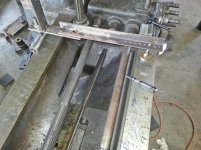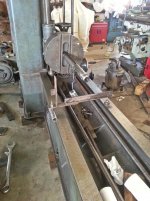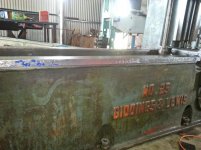RC99
Diamond
- Joined
- Mar 26, 2005
I have this G&L 25RT borer here that I was just wanting to tickle up the bedways a little bit... They are not worn very much, but enough so that with the gib adjusted at the most worn area, it is tight at the ends... I may end up doing all the bed ways...
It is all box ways, and is constrained vertically only on both sides of the left side box way where the leadscrew is...
What I am wondering is how to prepare the machine for scraping in so far as getting the base level.. The machine has eight jacking screws under it..

I have the horizontal underside of each box ways as an unworn area... And I have one vertical side of the right side box ways that is also unworn and could be used as a reference for straightness (hard for me to explain)


So what I want to do is level the base as it was when it was in the factory being made... I only have those small underside horizontal shears to use to level it up... Well that is as far as I know anyway... If it was sitting on a planer or bed grinder it would be very easy... Just run a dial indicator along them and adjust to 0-0 or so....
I will have to use a level.. Any ideas?
I had this set up here.... scraped square with a square level stuck to it... A frame level would probably be preferable.. Is that what one would do? Use something like a frame level and level along those small underside shears? Or is there some simple easy trick to do?
scraped square with a square level stuck to it... A frame level would probably be preferable.. Is that what one would do? Use something like a frame level and level along those small underside shears? Or is there some simple easy trick to do?
It is all box ways, and is constrained vertically only on both sides of the left side box way where the leadscrew is...
What I am wondering is how to prepare the machine for scraping in so far as getting the base level.. The machine has eight jacking screws under it..

I have the horizontal underside of each box ways as an unworn area... And I have one vertical side of the right side box ways that is also unworn and could be used as a reference for straightness (hard for me to explain)


So what I want to do is level the base as it was when it was in the factory being made... I only have those small underside horizontal shears to use to level it up... Well that is as far as I know anyway... If it was sitting on a planer or bed grinder it would be very easy... Just run a dial indicator along them and adjust to 0-0 or so....
I will have to use a level.. Any ideas?
I had this set up here....
 scraped square with a square level stuck to it... A frame level would probably be preferable.. Is that what one would do? Use something like a frame level and level along those small underside shears? Or is there some simple easy trick to do?
scraped square with a square level stuck to it... A frame level would probably be preferable.. Is that what one would do? Use something like a frame level and level along those small underside shears? Or is there some simple easy trick to do?






